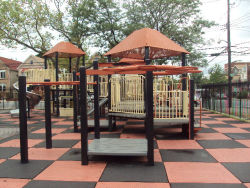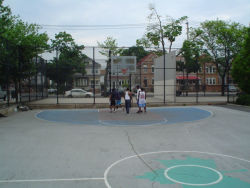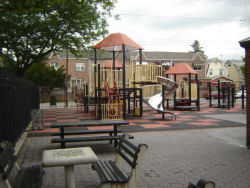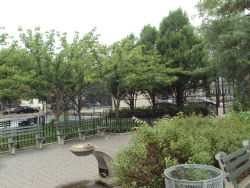Tilden Playground
Tilden Playground
What was here before?
As late as 1929, this site was occupied by Cornelius Suydam’s farm, which included a wood frame house. It was later occupied by privately-owned tennis courts, handball courts, and a field house.
How did this site become a playground?
The City of New York acquired the land for this playground in 1948. When it opened on October 2, 1950, this Brooklyn playground was the 532nd in the New York City Park system. It featured a tot play area and sports courts for older children, as well as a large free-play area that provided a space for roller skating or ice skating depending on the season.
In 1997 the park was redesigned using a storybook theme, recognizing Samuel J. Tilden’s philanthropy and the playground’s proximity to the Brooklyn Public Library’s Rugby Branch. Several concrete inlays in the shape of open books feature the classic novels Moby Dick, 20,000 Leagues Under the Sea, and Beauty and the Beast. The spray shower takes the form of two pencils poised above a giant crossword puzzle.
The playground’s tennis courts were reconstructed in 2013, and the building that houses the restrooms was rebuilt in 2023.
Who is this playground named for?
Like Tilden Avenue, which forms the northern border of this property, this playground is named after Samuel Jones Tilden (1814-1886), lawyer, governor, and candidate for President. Tilden was born on February 9, 1814 in New Lebanon, New York. He studied at both Yale College and the University of the City of New York (now New York University). Admitted to the bar in 1841, Tilden practiced law in New York City, representing high-profile clients including more than half the railway corporations north of the Ohio River and between the Hudson and Missouri Rivers.
Tilden was active in city, state, and national politics. He was elected to the state assembly in 1845, served in the Constitutional Convention of 1846, and ran on the Democratic ticket for Attorney General in 1855. He was a member of the Free Soil movement, which fought the extension of slavery into U.S. territories. By 1868 Tilden had assumed the leadership of the Democratic Party in New York State. In 1870 he launched a high-profile attack on the corrupt Tweed Ring, which had a stranglehold on New York City government from 1860 to 1871. Tilden helped to impeach several corrupt judges and exposed the plunder amassed by Tweed officials.
Campaigning as a reform candidate for the Democrats, Tilden was elected Governor of New York in 1874. His high-profile crusade against corruption won him the Democratic presidential nomination in 1876. Though Tilden won a majority of the popular vote, he lost the Electoral College by a single vote to Rutherford B. Hayes. The election was widely regarded as having been stolen by the Republicans, who formed the majority of the commission that was appointed to determine the vote of three Southern states, each of which had two sets of electors. Tilden’s bequest of his large book collection to establish a library ultimately led to the creation of the New York Public Library. He died at his home in Yonkers on August 4, 1886.
Check out your park's Vital Signs
Clean & Safe
Green & Resilient
Empowered & Engaged Users
Share your feedback or learn more about how this park is part of a
Vital Park System




